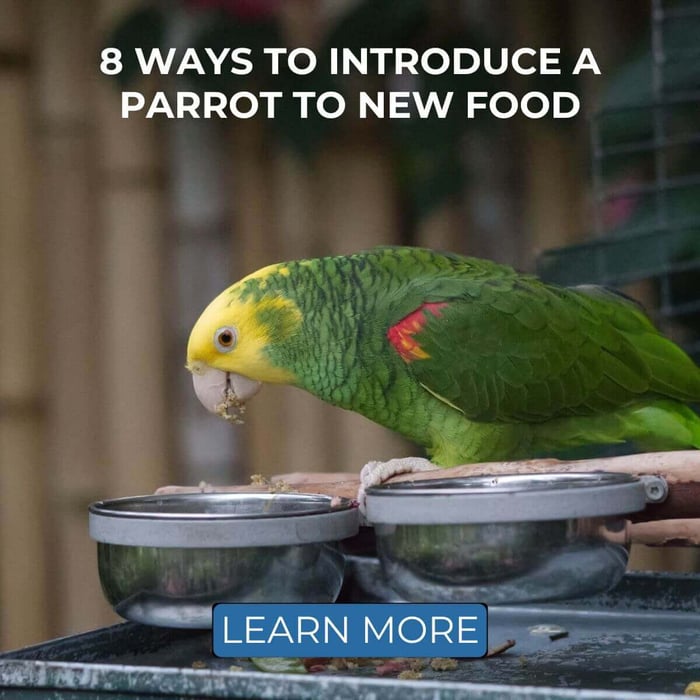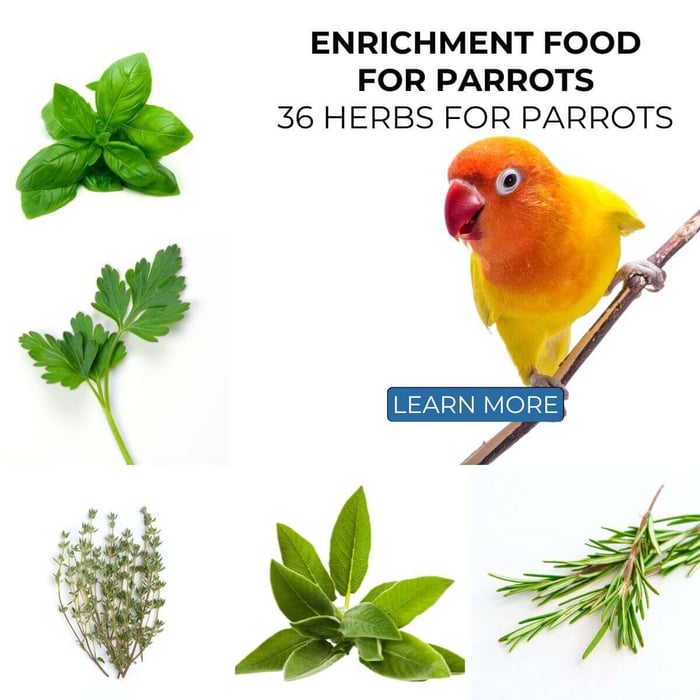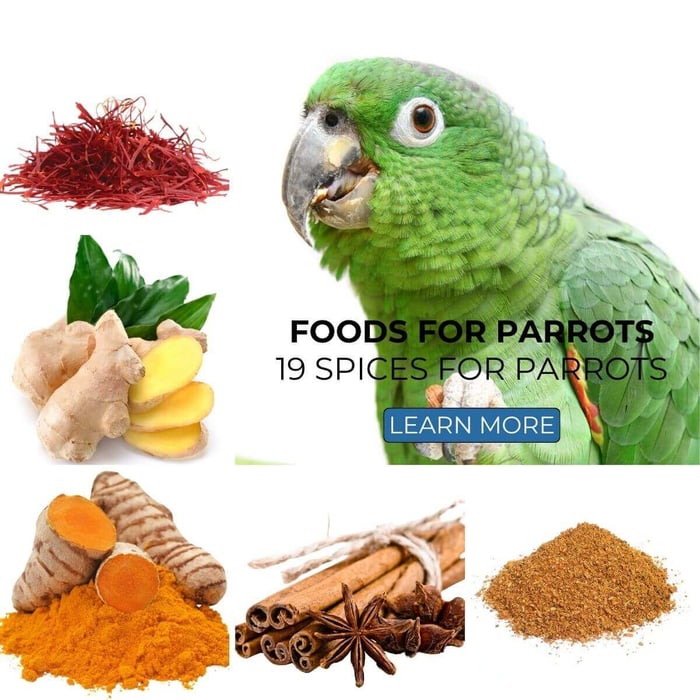Flowers for the Birds: 39 Safe Flowers for Parrots
If you’ve been a parrot owner for a while, you’ll know that our birds need a varied diet to thrive. You’ll also know that they get bored easily—and that you can use food as enrichment, like in a foraging setting. Another great way to stimulate your bird’s super-smart brain is to let it try new foods regularly! Did you know that there are many, many edible flowers for parrots out there. So, why not let your bird sample a few? Below, you’ll find a handy table outlining which ones are safe to feed and which aren’t.
Why Would You Give Your Parrot Flowers To Eat?

Did you know that many parrot species eat flowers and flower buds in the wild? Moreover, we’re not just talking about natural nectar eaters like lories and lorikeets either. Upon conducting some research, we found examples of anthophagy (the act of eating flowers) in many parrots, particularly those inhabiting rainforests.
"The diet of the Scaly-headed Parrot (Pionus maximiliani) was studied for three consecutive years. The parrots showed a generalist and seasonal diet. Seeds composed 70.4% of the diet of parrots, followed by flowers (20.3%), corn from plantations that surround the forest (7.7%) and fruit pulp (1.6%). In the dry season, flowers constitute 38 per cent of the diet."
We noticed differences among food items used by Yellow-faced Parrots between seasons. In the first wet season (January-April 2006), the diet was based on fruits (nearly 90%), followed by flower consumption (10%). In the second wet season (October 2006-January 2007), leaves were the most consumed item (47%), followed by fruits (32%) and flowers (21%). During the dry season, fruits were consumed the most (60%), followed by flowers (30%).
Diet and feeding behaviour of the yellow-faced parrot (Alipiopsitta xanthops) in Brasilia, Brazil
Parrots also extensively foraged on flowers during the dry season. Besides being plentiful, species such as Tabebuia heptaphylla and Inga vera annually produce abundant flower crops. Flowers from I. vera stood out among the major food resources of most parrot species, mainly for parakeets, which foraged on nectar primarily in the late dry season. However, even for the large Propyrrhura auricollis, nectar was an important food resource.
So, parrots eat flowers and flower nectar, particularly during the dry season when other foods may not be as abundant. The fact that it’s natural for them is the first compelling reason to offer your parrot flowers to eat, but it’s not the only one.
As we mentioned in the introduction, parrots naturally spend much of the day using their smart brains to find and access food. Consequently, in our homes, they get bored easily, so we should make an effort to keep them as busy as possible. Including new foods, particularly colourful and different things like flowers, is a great way to do this. Moreover, be sure to vary the presentation as well!
Last but not least, parrot-safe flowers are healthy for your bird. Not only are they low in calories, but they’re also rich in different vitamins and serve as a source of antioxidants. Furthermore, some specific types of flowers have additional health benefits. For instance, milk thistle is thought to contain compounds that help support liver function.
As should be clear by now, your parrot should probably be eating flowers. But which of the many blooms found in your garden (centre) are safe? There are many edible types, but also many that are toxic—some so toxic they’re deadly. That’s why we put together the handy table below.
39 Edible Flowers For Parrots (+ Unsafe Flowers To Avoid)
Considering feeding flowers but not sure about their safety for parrots? Here’s an alphabetical list of common garden flowers and whether they’re safe or not. Just scroll down to the name of the flower you’re unsure about (you can use CTRL+F or the search function in your phone browser to search for the common or scientific name) to find out the verdict.
We’ve divided the list up into four safety levels:
- Yes: You can feed it to your parrot multiple times a week without issue.
- In moderation: Fine, but don’t make it part of your parrot’s regular meals (usually due to high levels of essential oils).
- No: Keep this away from your parrot; otherwise, it can cause mild poisoning, leading to symptoms such as tummy ache, rash, etc.
- NO! Keep this away from your parrot AT ALL TIMES. Additionally, it can be fatal! If your parrot ate this, call your veterinarian right away. Also, be sure to tell them the scientific name of the plant in question.
Please note: We’re erring on the side of caution here. If there is conflicting information out there about a flower and we can’t verify its toxicity, we will mark it as a no.
Edible or Not? Flowers for parrots:
| Name | Safe for parrots? |
| African violet (Saintpaulia sp.) | Yes |
| Agapanthus (Agapanthus sp.) | No |
| Amaryllis (Amaryllis sp.) | NO! |
| Anemone (Anemone sp.) | NO! |
| Anise (Pimpinella anisum) | Yes |
| Aster (Aster sp.) | Depends on species! |
| Azalea (Rhododendron sp.) | NO! |
| Baby's breath (Gypsophila sp.) | No |
| Basil (Ocimum basilicum) | Yes |
| Bee balm (Monarda sp.) | Yes |
| Begonia (Begonia sp.) | No |
| Borage (Borago officinalis) | Yes |
| Bottlebrush (Callistemon sp.) | Yes |
| Buttercup (Ranunculus sp.) | NO! |
| Calendula (Calendula sp.) | Yes |
| Carnations (Dianthus caryophyllus) | Yes |
| Chamomile (Matricaria chamomilla & Chamaemelum nobile) | Yes |
| Chrysanthemum (Chrysanthemum sp.) | Yes |
| Citrus (lemon, orange, grapefruit, kumquat, etc.: Citrus sp.) | Yes |
| Cornflower (Centaurea cyanus) | Yes |
| Daffodil (Narcissus sp.) | NO! |
| Dahlia (Dahlia sp.) | No |
| Daisy (common daisy: Bellis perennis) | Yes |
| Dandelion (Taraxacum officinale) | Yes |
| Dill (Anethum graveolens) | Yes |
| Elderberry (Sambucus sp.) | Yes |
| Fennel (Foeniculum vulgare) | Yes |
| Foxglove (Digitalis sp.) | NO! |
| Gardenia (Gardenia sp.) | No |
| Geranium (Geranium sp.) | No |
| Gladiolus (Gladiolus sp.) | No |
| Hibiscus (Hibiscus sp.) | Yes |
| Honeysuckle (Lonicera sp.) | Yes |
| Hyacinth (Hyacinthus sp.) | NO! |
| Hydrangea (Hydrangea sp.) | NO! |
| Impatiens (Impatiens sp.) | Yes |
| Lavender (Lavandula sp.) | In moderation |
| Larkspur (Delphinium sp.) | NO! |
| Lilac (Syringa vulgaris) | Yes |
| Lilies (Lilium sp. & Hemerocallis sp.) | NO! |
| Magnolia (Magnolia sp.) | Yes |
| Marigold (Tagetes sp.) | Yes |
| Milk thistle (Silybum marianum) | Yes |
| Nasturtium (Tropaeolum majus) | Yes |
| Okra (Abelmoschus esculentus) | Yes |
| Oleander (Nerium sp.) | NO! |
| Oregano (Origanum vulgare) | In moderation |
| Passionflower (Passiflora sp.) | In moderation |
| Peony (Paeonia sp.) | No |
| Petunia (Petunia sp.) | Yes |
| Poppy (Papaver sp.) | NO!* |
| Rhododendron (Rhododendron sp.) | NO! |
| Rose (Rosa sp.) | Yes |
| Sage (Salvia officinalis) | In moderation |
| Snapdragon (Antirrhinum majus) | In moderation |
| Squash (zucchini, pumpkin, etc.: Cucurbita sp.) | Yes |
| Stonefruit (plum/cherry/apricot/almond/nectarine/peach; Prunus sp.) | Yes |
| Sunflower (Helianthus annuus) | Yes |
| Thyme (Thymus sp.) | In moderation |
| Tulip (Tulipa sp.) | No |
| Violet/pansy/johnny-jump-up (Viola sp.) | Yes |
| Yarrow (Achillea millefolium) | No |
| Zinnia (Zinnia sp.) | In moderation |
*Wild parrots sometimes actually get addicted to the opium in poppies. Not ideal for your pet bird.
How To Feed Flowers To Your Parrot
First off, the most important thing to keep in mind when feeding flowers to your parrot is that you should be aware of where they came from. Flowers picked by a busy roadside may be covered in soot particles, while those found near a crop field may have pesticide residue on them. You should never use flowers from a bouquet, either. Use your common sense!
If you want to be completely safe, you can easily grow some parrot-safe flowers in your own garden. In fact, since there are so many edible ornamental flowers, you may already be growing some without realising—just check them against the list. You can also opt to buy edible flowers for human consumption or go for dried flower mixes for parrots if you want a more economical option.
Obtained some blooms? Great! If your parrot is used to new foods, you can try offering them from your hand; it’ll likely tuck right in. But there are also other presentations you can consider:
- Incorporate flowers in your parrot’s daily fruit and vegetable chop.
- String flowers on some twine to make a dangling, edible parrot toy.
- Incorporate flowers in baked goods like homemade birdie bread.
- Brew a cup of flower tea by steeping the blooms in boiling water. Let cool, and let your bird have a try.
- If you have a lot of flowers, you can dry them in a dehydrator or in the oven for future use.
Conclusion
Flowers are a natural and healthy addition to your parrot’s diet. Moreover, if you can source or grow human-grade edible flowers, of which there are many types, you can incorporate them into your bird’s daily meals in all sorts of ways!
PS: Looking for more new, exciting and healthy things to feed your parrot? Have a look at our lists of parrot-safe spices and parrot-safe herbs for many more fun ideas using items you may already have in your pantry.




